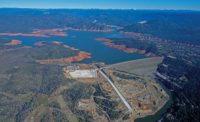Tustin
Key Players
Owner Naval Facilities Engineering Command, Southwest (NAVFAC SW)
Building Manager NAVFAC BRAC
Lead Design Firm Jacobs Engineering/Michael Baker International Joint Venture
Contractor Kellogg Brown & Root Services Inc.
Structural and MEP Engineer Michael Baker International
Engineering QA/QC Jacobs
Crane Subcontractor Mr. Crane
Geotechnical Engineer Shannon & Wilson Inc.
After a partial roof collapse at a 1940s-era blimp hangar on the former Marine Corps Air Station in Tustin, the building was red-tagged and no one was permitted to enter. Several of the roof’s 51 arched wood trusses were severed in the collapse and cantilevered from their bases on each side.
Due to risk of further collapse, crews could only access the building exterior, and had only 90 days to stabilize the 300-ft-wide, 1,060-ft-long, 178-ft-high structure. This ruled out traditional interior stabilization systems and any strategies that required long lead times for materials.
The resulting fix utilized 190-ft-tall prefabricated modular steel towers—normally used to support tower cranes—that were placed on each side of the hangar, supported by concrete raft foundations and guy wires with helical piers installed in the soil. Four steel cables on each side of the hangar attached to the top of the remaining portions of the wood trusses and linked up to the towers.
Early design submittals to the owner allowed steel tower construction to proceed while engineers completed the remaining design.
Highly experienced construction crews completed the job with a spotless safety record from work baskets suspended 170 ft above the ground while contending with the tight schedule, Santa Ana winds and risk of asbestos in the 70-year-old building.
A monitoring system tracked any displacement in the remaining wood structure and provided warning of impending hazards. A surveying base station at grade measured any small movements between prisms located on the hangar roof and the tops of the steel towers, while tilt meters watched for movement on the remaining truss members. Real-time data fed into a website where team members could instantly track any movements. Preset alarms could trigger e-mail and text message alerts to team members whenever expected movement levels were exceeded.






